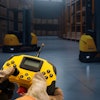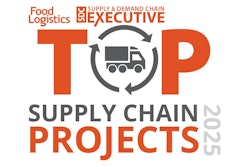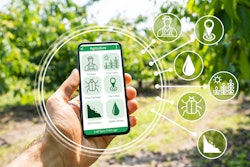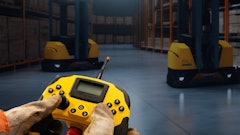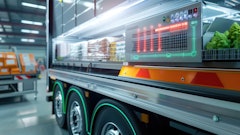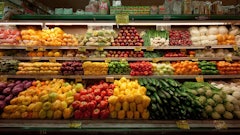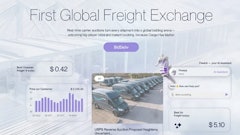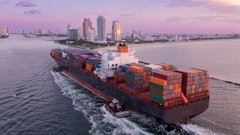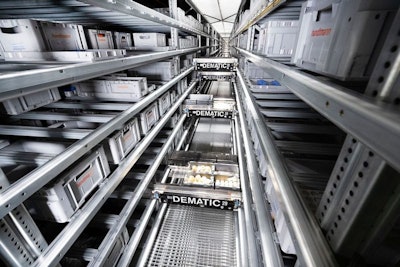
Anyone who moves food and beverage through the supply chain knows that the industry operates within a unique set of challenges. From maintaining product quality and safety to meeting strict regulatory requirements, companies in this space face constant pressure to perform efficiently while minimizing risks. These challenges are magnified in the cold chain, where precise temperature control is critical for perishable goods.
Take for example a grocery fulfillment center with a complex set of challenges: managing chilled and ambient inventory while ensuring temperature control and operational efficiency. Functionally, the operation needed to track the temperature of each gallon of milk and the location of every piece of produce.
The solution integrated real-time visibility software with totes equipped with temperature sensors. This pairing provided visibility into the conditions of goods throughout the facility. It was made possible by the advanced software, which not only monitors conditions but also optimizes workflows to ensure compliance with storage best practices. The software prioritizes storing replenished chilled items quickly to avoid spoilage, synchronizes picking tasks across temperature zones, and enforces inventory strategies like first in/first out (FIFO) and first expired/first out (FEFO).
The result? This distributor experienced a reduction in wasted products, enhanced compliance, and improved customer satisfaction — precisely what today’s food and beverage supply chain managers need to thrive.
Real-time visibility software is quickly transforming logistics for food and beverage environments, providing the tools necessary for proactive decision-making, operational efficiency, and regulatory compliance.
Enhancing food safety and efficiency
Temperature control is paramount in the food and beverage industry. Internet of Things (IoT)-enabled sensors continuously track conditions at every stage of the supply chain to confirm that all products remain within safe thresholds. If temperatures deviate, the software triggers real-time alerts, leading to swift corrective actions to preserve product integrity.
For instance, the grocery fulfillment center previously cited relied on these alerts to coordinate picking tasks across temperature zones, allowing perishable goods to be retrieved and consolidated without compromising quality.
This level of precision simplifies the process of meeting compliance with food safety standards. Real-time visibility software automates FIFO and FEFO processes, effectively managing inventory to reduce waste and prevent expired products from reaching consumers. Not only do expired goods result in health risks and expensive recalls, but they can damage reputations among consumers and the industry, which are not easily repaired.
Batch and lot tracking capabilities further enhance safety by facilitating rapid responses to quality control issues. If the software detects contamination from other products or non-food contaminants (such as cleaning supplies), the system can immediately lock down affected batches to isolate the risk and protect consumers.
Another advantage of real-time visibility within a warehouse or facility is dynamic inventory management. The software tracks expiration dates and stock levels in real time, prioritizing replenishment and fulfillment to reduce out-of-stock situations and waste. This ensures inventory is used optimally and customers remain satisfied with their orders.
Driving operational efficiency
By integrating data from sensors, robotics, and manual operations, real-time visibility software synchronizes workflows across the facility to drive operational efficiency. For example, the software ensures that items from different temperature zones are picked simultaneously and consolidated efficiently, saving time and reducing errors.
With this dynamic task prioritization, fulfillment managers can reduce downtime as well as optimize labor resources and storage space. Integration with automated equipment like automated storage and retrieval systems (AS/RSs) further enhances space utilization and throughput.
Finally, role-based dashboards provide tailored insights for operators, supervisors, and managers. Operators track specific tasks, while supervisors monitor overall performance and address bottlenecks. Artificial intelligence (AI)-powered predictive analytics also offer forecasting capabilities, enabling managers to adjust strategies proactively based on real-time data.
Is real-time visibility software right for your facility?
Several trends are driving the increased adoption of real-time visibility software and may provide a clear answer.
SKU proliferation is a major factor. As consumers demand more options among their food and beverage choices, the number of SKUs in warehouses continue to skyrocket. Managing the diversity of these inventories requires robust tracking and optimization tools far beyond what a simple spreadsheet or database can provide. More operations are turning to real-time visibility software to prevent overcrowding and inefficiencies.
The next trend? Cold chain complexity. The growing number of refrigerated and frozen goods has added layers of complexity to logistics operations. Real-time visibility software ensures that temperature-sensitive products remain within safe ranges throughout their journey, maintaining quality and compliance.
Sustainability goals are also driving software adoption. As companies seek to reduce waste, optimize delivery routes, and improve resource efficiency, real-time visibility software helps achieve environmental targets while improving operational performance.
What’s next for real-time visibility in food logistics
The future of real-time visibility software is shaped by emerging technologies and evolving industry needs.
IoT and AI are becoming standard tools for predictive maintenance, demand forecasting, and inventory optimization. Predictive analytics can identify trends in inventory usage, allowing companies to plan more effectively to avoid shortages or excess stock.
As business operations grow, logistics systems must keep pace. Modern, cloud-based software solutions scale seamlessly, accommodating more SKUs, larger facilities, and additional locations without disruption.
The software also allows stakeholders to access real-time data from anywhere, enhancing collaboration and providing faster decision-making processes. This is particularly valuable for distributed operations or remote teams.
In the fast-paced and safety-sensitive food and beverage industry, real-time visibility software has become a cornerstone of operational success. From temperature control and regulatory compliance to improved resource utilization and sustainability, operations can meet the challenges of modern logistics with confidence
Businesses that prioritize investment in real-time visibility software solutions will be better positioned to compete. It’s not just a technological upgrade — it’s a strategic imperative for ensuring safety, efficiency, and long-term success.

